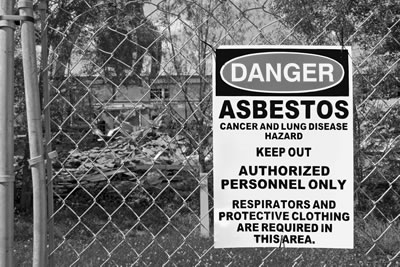
How Did I Get Asbestos Cancer?
How Was I Exposed?On-the-Job Exposure to Asbestos
If you have been diagnosed with mesothelioma, chances are good that you were exposed to asbestos through your job or military service. The exposure was probably not recent. Sometimes asbestos fibers can sit in the body for decades before the cancer becomes apparent. Asbestos was not regulated until 1971, and was common in many buildings and workplaces.
It is possible that a job you had 30 or more years ago exposed you to the asbestos that caused your cancer. So, as you discuss with your doctor and/or lawyer, keep in mind your entire work career.

Below are some of the more common jobs that have high rates of asbestos exposure:
Construction Workers/Contractors
Exposure can come from placing asbestos in buildings or from removing or repairing asbestos-containing products or equipment. Contractors get exposed when working with or around old pipes, electrical work, floor tiles, plaster walls, insulation or other products containing asbestos. You did not need to be working directly with asbestos to be exposed. It is possible you were exposed due to work around others who were working with asbestos.
Mechanics
Brake lines used asbestos for quite some time, and so mechanics who used to work on brakes are sometimes exposed and develop asbestos cancer. People who are not mechanics professionals but who work on cars or machines can be at risk too—for example, farmers who work on their tractors.
Naval veterans/merchant marines
Many naval ships had large boilers, turbines, valves and insulated piping. This equipment was often insulated with asbestos. Working on the crews of these ships has led to exposure in many cases, as has working on the ships themselves in a shipyard.
HVAC workers, boilermakers, and pipefitters
All of these jobs require working in tight spaces. Some of those tight spaces might have had asbestos, especially if there was older pipe insulation or an older boiler.
Machine workers and manufacturers
Many industrial processes have used asbestos as an insulator or flame retardant. Asbestos may also have been used to manufacture some items, like brake lines. Working in industry exposed many to asbestos during the manufacturing process.
Firefighters
Many firefighters have unfortunately also been exposed to asbestos. First, asbestos is a flame retardant, and so firefighters would sometimes come into contact with it in older equipment or demonstration materials. Second, they could have come into contact with airborne asbestos while saving an older home or building.
Railway workers
Older rail lines often used asbestos. It could be found in train cars, brake pads, rail ties, and pipes connected to steam engines. Though these have not been around for a while, railway workers are often exposed when old tracks are dug up.
Where is Asbestos Found?
For a long time, asbestos was used in a lot of places. It could be found in homes, in workplaces, and even on ships and trains.
Asbestos could be a part of many products and parts. For example, asbestos was commonly used in:
- Piping and pipe insulation
- Drywall and/or plaster
- Insulation
- Duct connectors
- Electrical components
- Floor tiles
- Ceiling tiles
- Shingles
- Glues and adhesives
- Brake lines
- Fireproof clothing and equipment
- Laboratory equipment
Asbestos was also common in certain kinds of consumer products—for example, hair dryers (insulated lining), pot holders, cookware, ashtrays, and coasters.
Things that Did NOT Cause Your Asbestos Cancer
Cancer is a frightening thing. When people are afraid of cancer, they spend a lot of time thinking about how it happened, and how it could have been prevented. That’s natural.
But people also speculate as to how they (or their loved ones) got cancer.
So, to clear the record, here are some things that we know scientifically, for a fact, do not cause mesothelioma:
- Smoking. Smoking is bad for you, and it can cause lung cancer. But it does not cause mesothelioma. Only exposure to asbestos does.
- Radon gas. Radon gas can be dangerous. And there is evidence that high amounts can cause lung cancer…but it does not cause mesothelioma.
- Fiberglass. Fiberglass has replaced asbestos in insulation and many other products. Because it has fibers, some people believe it can cause cancer, too. However, the medical community agrees that fiberglass does not cause mesothelioma. (That said, workers who install fiberglass insulation might be exposed if they remove older asbestos-based insulation first.)
- Being a man. It’s true: Men get mesothelioma at rates much higher than women. But this is likely because, traditionally, men were more likely than women to take jobs where they could be exposed: Construction workers, firefighters, industrial workers, etc. Being male is not a risk factor; having a job that exposed one to asbestos is.
- Agent Orange. Many veterans ask if Agent Orange could be a cause of mesothelioma. While the VA does recognize that Agent Orange could be the cause of some cancers (“soft tissue sarcomas”), it does not recognize it as a cause of mesothelioma. That said, many veterans are at risk if they worked on naval ships or aircraft with asbestos, or otherwise had exposure over the course of their service.
Wondering How You Were Exposed to Asbestos, and What to Do Now?
You’re not alone. Every year, hundreds of new cases of asbestos cancer emerge. Its widespread use in business, industry, and even consumer products made it hard for some people to avoid.
If you have a diagnosis of mesothelioma (asbestos cancer) or lung cancer, follow your doctor’s suggestions. Then contact a lawyer who specializes in asbestos exposure claims. You might have a case and could be entitled to a payout to help offset your medical bills and provide additional compensation.



